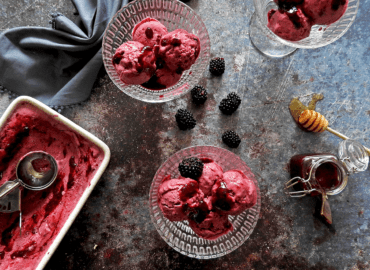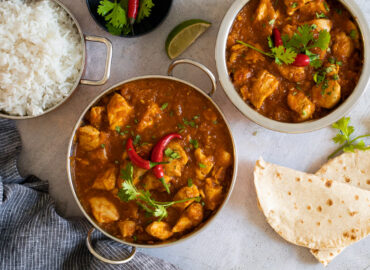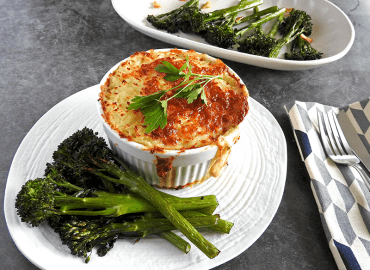*This post may contain affiliate links. Read my disclaimer here. While we may use affiliate links, we would never allow this to influence product listings or recommendations.
Poaching chicken is a great way to cook your meat without adding any extra fat or oil, keeping your meal light and sin-free. But poached doesn’t have to mean bland! Read on to find out how to poach chicken and prepare the most tender and succulent breasts you’ve ever made, along with a variety of flavour inspirations.
What does poaching mean?
If you love cooking, you’ve probably heard the term “poaching” used before. But what does it actually mean? Poaching is a cooking technique in which food is cooked in liquid, typically water or broth. The liquid is kept at a very low simmer so that the food gently cooks through without becoming tough or dry. Poaching is often used for delicate foods like eggs and fish, which can easily fall apart if cooked too quickly, and it works great for chicken too! When done correctly, poaching results in food that is moist and flavourful.
What are the benefits of poaching chicken?
While it may not be the most glamorous cooking method, poaching chicken can actually be quite beneficial. For one thing, it is a very healthy way to prepare meat. Since the chicken is cooked in water, there is no need to add any additional oil or fat. This makes it a great option for those who are trying to eat lighter. Additionally, poaching chicken can help to keep the meat moist and flavourful. When chicken is cooked using dry heat methods such as frying or grilling, the juices can quickly evaporate, making the meat dry and tough. However, because poaching chicken involves cooking it in liquid, it retains more moisture, resulting in a juicier and more tender final product.
Poached chicken can also be easily customised to suit any flavour profile. Simply adding different herbs or spices to the poaching liquid can create a completely new dish. Perhaps best of all, poaching is one of the quickest and easiest ways to cook chicken.
How do I add flavour?
There are so many ways you can add flavour to poached chicken. Cook it with aromatic vegetables. chopped onion, garlic, celery or ginger. Another option is to add some spices to the poaching liquid. Popular choices include bay leaves, peppercorns and fresh herbs.
You simply need to add the ingredients to the poaching liquid before cooking. A few ideas to try are:
- Classic poached chicken with lemon, rosemary and garlic
- Asian-inspired chicken with ginger, spring onion, lemongrass, chilli and garlic
- Winter spiced chicken breasts with shallots, cloves, cinnamon and thyme

What type of chicken can be poached?
The great news is that you can poach pretty much any cut of chicken. The one part that doesn’t poach well is chicken skin as you can’t achieve that crisp golden coating to your fillet. However, you can poach the skin too, if you are planning to remove it before eating. It will actually slide right off after cooking.
Do I start with hot or cold water?
To get the juiciest poached chicken you should start with cold water. This will bring the chicken up to the cooking temperature more evenly, ensuring it cooks consistently throughout. If you start with hot water then the chicken will poach on the outside before the inside rises to the temperature needed to start cooking.
How long does it take to poach chicken?
When poaching chicken using my method (cold water brought to a low simmer) then the amount of time it will take depends on a few factors. The volume of water used will have a significant impact since you need to bring this to a low simmer after adding the chicken. The more water you use, the longer this will take.
Once the water reaches a low simmer it will take around 10-12 minutes to poach a medium-sized chicken breast (around 120-150g / 4-5oz). If you are using larger breasts you may need to increase the cooking time by an additional 5-10 minutes. The best way to check that it is done is to use a kitchen thermometer. Remove the chicken when it reaches 68-70C (155 – 158F) then leave it to rest for 5 minutes which will allow it to come up to the recommended temperature of 75C (165F).

How long does it keep?
Poached chicken can be kept in the same manner as chicken cooked via other methods. It will keep in the fridge for up to 3 days or frozen for up to 3 months.
Since poached chicken is excellent to toss into salads or sandwiches this makes it ideal to have a breast or two ready in the fridge for whenever you need them.
If you want to reheat the poached chicken then there are a few things you can do to make sure it stays juicy and tender. If microwaving add it to a bowl with a splash of water and cover before zapping. You can also reheat it on the hob/stove by placing it in a pan with a small amount of water and letting it simmer for a few minutes, turning the breasts halfway through. This is also a particularly good method if you have shredded or sliced the chicken.
Why do you need to rest meat?
It’s always worth making sure you allow for time to rest meat after cooking. For one thing, it allows the juices to redistribute, ensuring that your fillet is evenly cooked and juicy throughout. When meat is cooked, the proteins begin to contract and squeeze out the juices. If you carved into the chicken immediately, all of those delicious juices would run out, leaving your meat dry. By letting the chicken rest, you give the proteins time to relax and reabsorb the juices.
Finally, resting meat also allows it to reach a safe internal temperature, as the juices in the chicken will continue to simmer even after it has been removed from the heat source. If you time everything right (or use a kitchen thermometer to be on the safe side) then this means you will have chicken cooked to exactly the right temperature and no further, which would lead to it becoming tough.

What can I use poached chicken for?
There are endless possibilities when it comes to what you can do with poached chicken. It’s perfect for salads. Try it in this chicken and bacon salad or this curried chicken salad.
You can also shred it and add it to soups or wraps. Why not try this slow cooker coconut chicken soup. Simply add the chicken at the end of the cooking time to warm through.
If you’re feeling a bit more adventurous you can add it to a curry such as this chicken rogan josh. You could also try this teriyaki chicken donburi or this chicken and chorizo jambalaya.
Ingredients
For a full list of ingredients, with weights and measurements, jump to the printable recipe card.

- Salt
- Black pepper
- Rosemary
- Lemon, sliced
- Garlic, smashed with the flat side of a knife
- Chicken breasts – skinless and boneless
How do I poach chicken?
For more detailed instructions with tips jump to the printable recipe card.

- Place the herbs and flavouring in a pan of cold water.
- Add the chicken to the pan and place over medium-high heat.
- When it just starts to bubble (one or two bubbles breaking the surface every few seconds) then reduce the heat to medium and keep it at that level for 10 minutes.
- At the end of the 10 minutes cooking time, the chicken should be cooked through. If you want to be on the safe side you can check it with a thermometer. The temperature in the fattest part of the breast should be 68-70C (155 – 158F) when it comes out of the water. It will continue to cook as it rests and will then reach 75C (165F).
- Use a slotted spoon or tongs to set the chicken aside on a board or plate. Leave the breasts to rest for 5 minutes before slicing or serving.
Top tips for poaching chicken
- Use a wide pan when poaching chicken, particularly if you are cooking multiple breasts. You want to allow the pieces to sit next to each other in the pan with a little room around them. You don’t want them stacked on top of each other in a crowded pan.
- Use around 10-12cm of water (or 4-5″). There should be enough to fully submerge the chicken with a little room above them. If you use too much water then it will take longer to heat up and it will extend the cooking time unnecessarily.
- Always remember that you are poaching the chicken. Not boiling it and not simmering it. Poaching is a very gentle cooking method and if you use too high a heat then the result will be dry and tough.
- You can strain and keep the leftover cooking water and use it in place of stock. It will last for up to 3 days in the fridge or for up to 3 months in the freezer.
- When slicing the chicken, cut it at a 90-degree angle to the grain (the lines you can see running through the breast). Cutting across the fibres will make it even more tender.
Looking for more great chicken recipes? Try:
- Harissa chicken
- Sweet and sour chicken (Hong Kong style)
- Tarragon chicken
- Chicken pasanda
- Hunter’s chicken

How to Poach Chicken
- Total Time: 20 minutes
- Yield: 4 1x
Description
Find out how to poach chicken and prepare the most tender and succulent breasts you’ve ever made, along with a variety of flavour inspirations
Ingredients
- 1 tsp sea salt
- 1 tsp black peppercorns
- 2–3 sprigs of rosemary
- 1 lemon, sliced
- 4 garlic cloves, smashed with the flat side of a knife
- 4 chicken breasts, skinless and boneless (see note 1)
Instructions
- Fill a wide pan with around 10cm/4″ of cold water. Add the salt, pepper, rosemary, lemon and garlic. (see note 2)
- Lower the chicken breasts into the water so they sit side by side (not stacked on top of each other). (see note 3)
- Place the pan over medium-high heat and bring to a very low simmer. You want a bubble or two to be breaking the surface of the water every couple of seconds, no more.
- Reduce the heat to medium, so you keep the water at this temperature. Cook for 10 minutes. (see notes 4,5)
- Remove the chicken from the water with tongs or a slotted spoon and place it aside on a plate or chopping board. You can check they are done enough by using a kitchen thermometer and checking they register at 68-70C (155 – 158F) in the thickest part of the breast. Or you can cut a small slit into the middle of one of the breasts and check it is white all the way through. (see note 6)
- Leave the chicken to rest for 5 minutes before serving or slicing. (see notes 7,8)
Notes
- You can also poach chicken thighs or legs using the same method. If you are using chicken with skin then the skin won’t be great for eating once poached as it won’t be crisp. However, it will fall right off the chicken once cooked.
- Feel free to get adventurous with the seasonings you add. You can use any whole spices and seeds, herbs or vegetables!
- There should be enough water to fully submerge the chicken with a little room above. If you use too much water then it will take longer to heat up and it will extend the cooking time unnecessarily.
- Always remember that you are poaching the chicken. Not boiling it and not simmering it. Poaching is a very gentle cooking method and if you use too high a heat then the result will be dry and tough.
- 10 minutes is usually a good amount of time for a medium-sized chicken breast (around 120g – 150g each (4-5oz)). If your breasts are larger you may need to add an extra 5-10 minutes of cooking time.
- You can strain and keep the leftover cooking water and use it in place of stock. It will last for up to 3 days in the fridge or for up to 3 months in the freezer.
- Don’t skip resting the chicken. If you have cooked it to the recommended temperature, then while resting it will continue cooking until it reaches 75C (165F) which is the recommended safe temperature for cooked chicken. It also allows the fibres to relax and the juices to redistribute through the chicken, making it super juicy and tender.
- When slicing the chicken, cut it at a 90-degree angle to the grain (the lines you can see running through the breast). Cutting across the fibres will make it even more tender.
- Poached chicken can be kept in the fridge for up to 3 days, or frozen for up to 3 months.
- When reheating add a splash of water and cover and cook in the microwave. Or heat in a small amount of water in a pan on the hob/stove to retain the juiciness.
- Nutritional information is based on 1 boneless and skinless chicken breast weight 125g (4oz).
- Prep Time: 5 minutes
- Cook Time: 15 minutes
- Category: Chicken
- Method: Hob / Stove
- Cuisine: British
Nutrition
- Serving Size: 1
- Calories: 132
- Fat: 1.4g
- Carbohydrates: 0g
- Protein: 30g
Keywords: chicken, poached, healthy, light, easy, simple, keto





